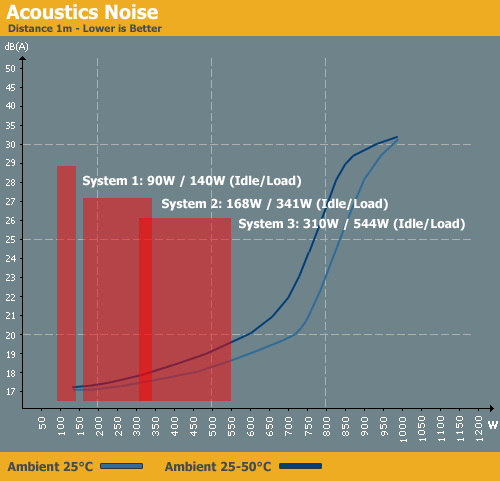Debunking Power Supply Myths
by Christoph Katzer on September 22, 2008 3:00 AM EST- Posted in
- Cases/Cooling/PSUs
What about Noise?
Efficiency isn't the only aspect of power supply performance to consider. Noise levels are also important. Sticking with our previous example of the Cooler Master UCP 900W, we get the following chart:

All three of our test systems allow this power supply to remain virtually silent. Even with our high-end system, power supply noise should not be much of a concern. In order to achieve a power draw of 550W, you will need to have a lot of power-hungry components, and these will almost certainly drown out any noise created by this particular power supply. Naturally, this is one of the benefits of choosing a power supply rated much higher than what you actually need: it will always stay virtually silent.

Any of our three sample systems will allow this power supply to run at less than 20 dB(A). Not surprisingly, this is the sort of comment we see on forums. "I have PSU XYZ, and I never hear it when my system is running!" That might be true, but without knowing the system components and operating load, such a statement provides the very little useful information -- especially when discussing an 800W or larger PSU. We prefer to push power supplies to their limits to see what actually happens when you begin to tax them. Midrange and high-end systems almost always have plenty of other fans that will drown out such a power supply.










98 Comments
View All Comments
Christoph Katzer - Monday, September 22, 2008 - link
Yes I guess that was the problem. Thanks for pointing that out!ViRGE - Monday, September 22, 2008 - link
Christoph, thanks for the excellent article. There is one thing I noticed however that has me a bit confused. In a few of your video card tests, you have the cards pulling upwards of 100 watts from the PCIe slot. It has been my understanding, and is mentioned in AT's X38 chipset article*, that the limit for a PCIe slot is 75W. Your results put this value in contention, so I'm not sure what to believe at this point.Is it that I am mistaken that the limit is 75W, or are your video cards pulling too much power from the slot, or is there a problem with the data?
Christoph Katzer - Monday, September 22, 2008 - link
Thanks. The data is correct since the cards draw power through the PCIE slot and the additional PEG connectors (6-pin or 8-pin). Towards the end of the article you will find a list which card drew how much power from the PCIE slot and the PEG connector. 75 watts is however correct for the older PCIE slots, PCIE2.0 can draw up to 150 watts.mobutu - Monday, September 22, 2008 - link
Where is AMD 4850?Also almost all the graph cards used are kind of old, previous generation.
Dobs - Monday, September 22, 2008 - link
Here is a link to a comprehensive list of all graphics cards.Dobs - Monday, September 22, 2008 - link
damn... link didn't workCopy and paste :)
http://archive.atomicmpc.com.au/forums.asp?s=2&...">http://archive.atomicmpc.com.au/forums.asp?s=2&...
Clauzii - Monday, September 22, 2008 - link
Nice lists, thanks :)Christoph Katzer - Monday, September 22, 2008 - link
As stated I didn't have all of the new stuff here and this article anyway focuses primarily on power supplies and how to choose them and not the power consumption of the components... but it might come soon, who knows.LTG - Monday, September 22, 2008 - link
>>our labs don't have the latest GPUs available for testingIsn't this kind of a bad thing for a site with so many enthusiast readers?
First two caveats:
1) There are a lot of article bashers out there who nit-pick, give rude feedback, or are just plain wrong, I don't support these guys or want to be one.
2) The article written was very good and helpful, thank you.
However it doesn't matter that the article "primarily focused on how to choose power supplies".
- Leaving out a GTX 280 was a big omission. Even better to have an stock OC'd product.
- Leaving out very basic overclock numbers was a big omission. For example it's very common for readers to have an Intel QC clocked at 3.6Ghz since it's so doable.
Having the last two data points would be very helpful for those building top systems, and would even be interesting for those who are not.
7Enigma - Monday, September 22, 2008 - link
As mentioned, the article is about the myth that we all need 1k PSU's for the "best experience". Bottom line this article shows that the vast majority of people do not need more than a 500-600w psu. How is leaving out any stock product an omission? Just look at the TDP of the product and go from there. All stock products will fall within a narrow range.Once you get to OC'ing I also think this is a difficult thing to do. Individual chips, even from the same batch can have very different properties and require different voltages to reach the same speeds. I'm sure if the author had put that his Intel quad drew 120w at 3.6GHz, someone would have complained that their's took 135w, and someone else only 110w...Once you go above stock, it is not cut and dry and as the article states you should have a 20-30% extra buffer if you wish to OC.
I feel the scope of the article just doesn't require these extra requests. Sure it would be nice to see just how crazy of a system you can make (if I remember correctly they did that a while ago to actually use the >1000w supplies), but this article was to show what a normal base, mid-grade, and high-end setup would require.
I've complained in the past about articles, but this one I don't see any serious faults.